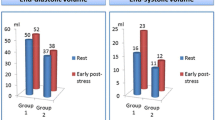Abstract
The purpose of this study was to compare semi-quantitative visual scores of perfusion, motion and thickening with an automated hypoperfusion index (HI) in patients with suspected acute inferolateral perfusion defects. In the absence of perfusion defects motion and thickening abnormalities were assessed. Sixty-eight patients with chest pain at rest and either ST depression ≥0.1 mV in ≥1 of leads I, aVL, V1–V6 on 12-lead ECG or ST elevation ≥0.05 mV in ≥1 posterior lead on the body surface map comprised the study population. A rest gated perfusion scan was performed within 24 h of symptoms. Scans were scored for perfusion, motion and thickening semi-quantitatively. The scores were compared to the automated HI. A 12 h Troponin T >0.09 ng/ml indicated myocardial infarction (MI). Sixty-five patients (96%, 65/68) had MI. The summed perfusion score correlated well with the HI (ρ = 0.90, P < 0.01) and agreement between scorers was good (κ = 0.77, 95% CI = 0.57–0.94). The summed motion score correlated with the HI (ρ = −0.61, P < 0.01) and agreement between scorers was moderate (κ = 0.65, 95% CI = 0.52–0.79). Summed thickening score correlated with HI (ρ = −0.67, P < 0.01) and agreement between scorers was good (κ = 0.74, 95% CI = 0.64–0.88). Of the 1156 segments assessed (68 × 17), 542 had normal perfusion. Of these normally perfused segments, 113 (21%, 113/542) had a motion abnormality and 102 (19%, 102/542) had a thickening abnormality. Three patients with proven myocardial infarction had normal myocardial perfusion (HI ≤ 5) but exhibited wall motion and thickening abnormalities. In conclusion, assessment of wall motion and thickening in addition to perfusion in acute myocardial perfusion imaging may improve the diagnostic sensitivity for acute MI. Of the scores addressing motion and thickening, interobserver agreement was better for the summed thickening score.




Similar content being viewed by others
References
Varetto T, Cantalupi D, Altieri A, Orlandi C (1993) Emergency room technetium-99 m sestamibi imaging to rule out acute myocardial ischemic events in patients with nondiagnostic electrocardiograms. J Am Coll Cardiol 22:1804–1808
Kontos MC, Jesse RL, Schmidt KL, Ornato JP, Tatum JL (1997) Value of acute rest sestamibi perfusion imaging for evaluation of patients admitted to the emergency department with chest pain. J Am Coll Cardiol 30:976–982
Heller GV, Stowers SA, Hendel RC, Herman SD, Daher E, Ahlberg AW et al (1998) Clinical value of acute rest technetium-99 m tetrofosmin tomographic myocardial perfusion imaging in patients with acute chest pain and nondiagnostic electrocardiograms. J Am Coll Cardiol 31:1011–1017
Udelson JE, Beshansky JR, Ballin DS, Feldman JA, Griffith JL, Heller GV et al (2002) Myocardial perfusion imaging for evaluation and triage of patients with suspected acute cardiac ischaemia: a randomised controlled trial. JAMA 288:2693–2700
Bilodeau L, Theroux P, Gregoire J, Gagnon D, Arsenault A (1991) Technetium-99 m sestamibi tomography in patients with spontaneous chest pain: correlations with clinical, electrocardiographic and angiographic findings. J Am Coll Cardiol 18:1684–1691
Jeroudi MO, Cheirif J, Habib G, Bolli R (1994) Prolonged wall motion abnormalities after chest pain at rest in patients with unstable angina: a possible manifestation of myocardial stunning. Am Heart J 127:1241–1250
Gerber BL, Wijns W, Vanoverschelde JL, Heyndrickx GR, De Bruyne B, Bartunek J et al (1999) Myocardial perfusion and oxygen consumption in reperfused noninfarcted dysfunctional myocardium after unstable angina: direct evidence for myocardial stunning in humans. J Am Coll Cardiol 34:1939–1946
Owens C, McClelland A, Walsh S, Smith B, Adgey J (2008) Comparison of value of leads from body surface maps to 12-lead electrocardiogram for diagnosis of acute myocardial infarction. Am J Cardiol 102:257–265
Joint European Society of Cardiology/American College of Cardiology Committee (2000) Myocardial infarction redefined—a consensus document of The Joint European Society of Cardiology/American College of Cardiology Committee for the redefinition of myocardial infarction. Eur Heart J 21:1502–1513
Benoit T, Vivegnis D, Foulon J, Rigo P (1996) Quantitative evaluation of myocardial single-photon emission tomographic imaging: application to the measurement of perfusion defect size and severity. Eur J Nucl Med 23:1603–1612
Smith WH, Kastner RJ, Calnon DA, Segalla D, Beller GA, Watson DD (1997) Quantitative gated single photon emission computed tomography imaging: a counts-based method for display and measurement of regional and global ventricular systolic function. J Nucl Cardiol 4:451–463
Marcassa C, Marzullo P, Parodi O, Sambuceti G, L’Abbate A (1990) A new method for noninvasive quantification of segmental myocardial wall thickening using technetium-99 m sestamibi 2-methoxy-isobutyl-isonitrile scintigraphy—results in normal subjects. J Nucl Med 31:173–177
Lang RM, Bierig M, Devereux RB, Flaschkampf FA, Foster E, Pellikka PA et al (2005) American Society of Echocardiography’s Guidelines and Standards Committee and European Association of Echocardiography. Recommendations for chamber quantification: a report from the American Society of Echocardiography’s Guidelines and Standards Committee and the Chamber Quantification Writing Group, developed in conjunction with the European Association of Echocardiography, a branch of the European Society of Cardiology. J Am Soc Echocardiogr 18:1440–1463
Christian TF, Clements IP, Gibbons RJ (1991) Non invasive identification of myocardium at risk in patients with acute myocardial infarction and nondiagnostic electrocardiograms with Technetium-99 m-sestamibi. Circulation 83:1615–1620
Hachamovitch R, Berman DS, Kiat H, Cohen I, Cabico A, Friedman J et al (1996) Exercise myocardial perfusion SPECT in patients without known coronary artery disease. Incremental prognostic value and use in risk stratification. Circulation 93:905–914
Acknowledgments
This work was completed with the assistance of Mrs B Smith SRN, Miss A Tomlin SN, and Mrs Helen Long MSC BSE Chief Cardiac Physiologist and her department. This work was supported by a research grant from the British Heart Foundation [Grant number: PG/04/105/17734].
Conflict of interest statement
None.
Author information
Authors and Affiliations
Corresponding author
Rights and permissions
About this article
Cite this article
Neill, J., Harbinson, M. & Adgey, J. Myocardial wall motion and thickening assessment in early gated SPECT images of acute coronary syndrome patients likely to have inferolateral perfusion defects. Int J Cardiovasc Imaging 26, 881–891 (2010). https://doi.org/10.1007/s10554-010-9641-0
Received:
Accepted:
Published:
Issue Date:
DOI: https://doi.org/10.1007/s10554-010-9641-0




